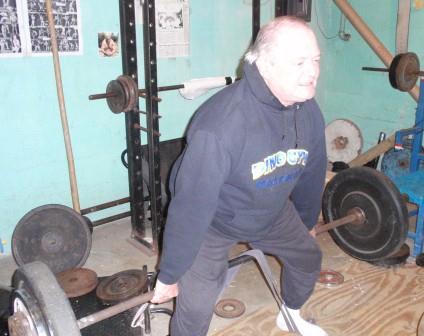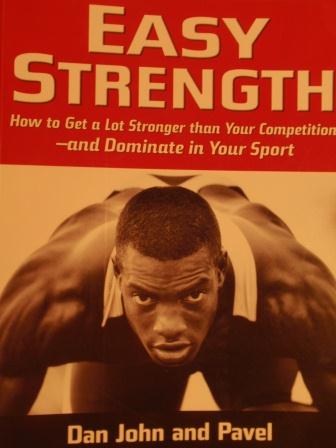MIM
by John McKean
“Oooh, Hon, how sweet – you remembered the nickname my family gave me when I was young!” purred my wife, Marilyn.
I noticed she was staring at a crumpled piece of paper I’d recently started scribbling on, that carried only the title “MIM.” So, thinking quickly, I replied “Yep, ya caught me. I was just penning you a little love note!” For certainly I would’ve lost this year’s batch of her famous Christmas cookies had I mentioned that the note was the nickname, and to be the recording of my current training routine, which stood for “Monkey In the Middle”!!
The MIM style workout refers to the middle-weight sets or “monkey,” and is my latest version of the “backdown set.” I learned about backdowns during the 1960s from famous Pittsburgh powerlifter Bob Weaver. Big Bob was one of our first National superheavyweight champions, using his 365 pound bulk to establish the U.S. record total and a national squat record of 807 – long before supersuits or other supportive gear, and when judging was STRICT. Bob typically would start his training squats with a set of 5 with 135 pounds on the bar, and add a pair of 45s for every set thereafter, until it stopped him. Then he’d reduce to a couple of hundred pounds lighter and bang out a few FAST sets – this was, of course, the backdown work. By the way, an amusing incident of his progressive training – Bob most often didn’t pay attention to the total amount of weight continually stacked on and once found, after the fact, his final set to be 855; yes, he got stuck with no spotters around. But, the experienced squatter had a trick he used for such emergencies – he’d quickly frog-hop forward and shove the bar backwards (he taught this to me – it really worked and was actually more reliable and safer than half awake spotters!). Trouble was, ole Bob had his back to a big window on the second floor of the Oakland (uptown Pittsburgh) YMHA – it went right through the glass and a massively loaded, plate clanging Olympic set tumbled to the sidewalk below! Fortunately, the horrific crash was on a small, little used side street at night, so no one was nearby! Not that any of their cars were parked down there either, but the Y’s directors weren’t exactly laughing!
Anyway, MY “backdown” is what I consider the MAIN building set(done as “rest-pause” singles), as this is where I place bands over the barbell for “speed singles.” Usually used for training our various all-round deadlift type lifts, I begin a session with a non banded double using a medium weight, go to a heavy single (not a limit but enough to cause a bit of a strain!), then backdown to a weight right in the middle of those two sets for band work. I start these “monkey sets” with a normal initial pull, but then try to accelerate through the finish. These sets actually feel springy and easy, since they follow the heavy single for the day, yet are actually more resistant due to the extra band stress. Since they begin easier off the floor, I am able to “trick” the body into a harder, faster lift! Each subsequent middle weight single seem to become more vigorous and speedier! An important footnote – if I’d not use a heavy free weight single beforehand, the monkey speed singles couldn’t be performed as efficiently with quite as much weight.
However, don’t go crazy with band speed singles. I find 2 to, at most, 5 banded-bar singles will do the job. In fact, in the brand new book EASY STRENGTH by Pavel and Dan John (Dragon Door Publications), Pavel mentions a similar banded deadlift routine that I’d once given him. He wrote that the speed singles seemed just too easy and merely 5 of them were probably only good for old men (like me!!). But after his first workout he learned the hard way that this is a MINIMUM quantity, high quality routine (he stuck to 5 or 6 thereafter and claimed he was so strong with such little work that it seemed like “cheating”!). For that matter, throughout the entire EASY STRENGTH text the authors continually stress the extreme value of employing minimum reps and sets for optimum strength gains. It’s one of the few teaching tools that elaborate on TRUE strength strategies for athletes, as the old time lifters employed – our all-round forefathers!
“By the way, Hubby,” cooed Marilyn. “What were you gonna tell me in your love note?”
“OH,” said I. “Just those three little words you always like to hear!”
“Really?” she gushed.
“Yep,” I whispered, ” Bake them cookies!”
I never learn.

